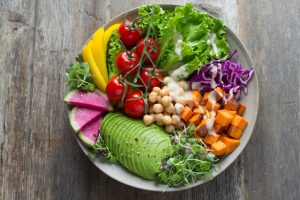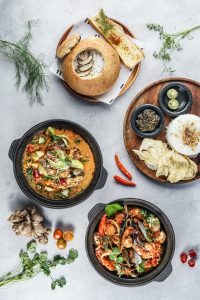Look for saffron that has been grown using organic methods, or at least without the use of chemical pesticides.
Saffron is a spice derived from the flower of Crocus sativus, commonly known as the “saffron crocus”. The vivid crimson stigmas and styles, called threads, are collected and dried to be used mainly as a seasoning and colouring agent in food. Saffron, long among the world’s most costly spices by weight, was probably first cultivated in Greece. It has for centuries been an article of trade and tribute.
Selection: Choose saffron from a reputable site that is 100% pure. There are many fakes out there so beware! You can always send it to a lab to have it checked to ensure it is true saffron.
Steeping: To steep saffron you need very hot water – boiling or near boiling – and a glass container with lid (e.g., mason jar). You then add 10 threads of saffron for every 1 cup of water you’re steeping. So if your recipe calls for 2 cups of water then add 20 threads of saffron. Any higher than 10 threads per cup may produce bitterness so stick
With all of the saffron in the market, it can be difficult to choose quality saffron. Here are a few tips that we use when selecting our saffron.
Look for deep red threads and not orange or yellow.
Check the color of the stigma. The color should be vivid and uniform.
Check that there are no yellow styles present in the threads. The threads should not break easily.
The aroma is as important as its flavor. If you are buying from a store, ask for a sample so that you can smell it before buying it.
One of the most important aspects of choosing saffron threads is to select a spice that has a deep red color. You may also see some saffron that has an orange or yellow tint, but these are not good quality saffron threads. The deep red color will yield a deeper, richer taste and color when cooked with. This is extremely important because many saffron producers mix in other ingredients to enhance the color of their spice.
To check for high quality saffron, take one thread and break it apart with your fingers. If the inside has a yellow or orange tint, then you know it’s not pure. It’s also important to make sure the saffron threads have a smooth texture; if they’re rough, they’ve been mixed with another spice such as turmeric to give them bulk.
Saffron is a spice derived from the flower of Crocus sativus, commonly known as the “saffron crocus”. The vivid crimson stigmas and styles, called threads, are collected and dried to be used mainly as a seasoning and colouring agent in food. Saffron has long been the world’s most costly spice by weight. Although some doubts remain on its origin, it is believed that saffron originated in Iran. C. sativus is possibly a triploid form of C. cartwrightianus.
What makes saffron so expensive?
Saffron is painstakingly hand-picked; each flower only produces three stigmas, which must be carefully removed from the flower and then dried. To produce one pound of saffron, you need 50,000–75,000 flowers, or 170–250 flowers per gram! It takes around 4 hours of labour to produce one gram of dried product!
How can I make sure that I’m buying quality saffron?
The most important part about buying good quality saffron is knowing a few key pointers:
Saffron should have a deep red colour with some orange streaks towards the end (the lighter coloured parts). The stigma should
The quality of Saffron is a multifaceted issue. The price is one of the markers for the quality of a spice. In Saffron you have to consider the cut, color, and aroma as well. What is used in the spice extract, is the stigma or the entire saffron flower. The stigma is an orange red thread like substance that comes from inside the flower itself. The stigma has a bitter taste and that can be dissolved in water and alcohol. If you are looking for a saffron with a lot of strength, you look for a stigma that has been dried properly and has a more intense red color to it. The more intense red color means that it has more Crocin which is what gives saffron its color and flavor.
Aroma can be another way to determine the quality of Saffron. The aroma is the fragrance of the spice. To test this out you can take it in your hands and slightly rub it between your fingers to see if it releases its aroma or not. Another way to test this out, is to put it on top of your tongue and move it around with your tongue slightly to release its aroma that way as well. The stronger its scent, the better its quality will be as well as
Saffron is the most expensive spice in the world. It’s made by hand, with each crocus flower producing three saffron threads. A pound of saffron requires about 50,000 flowers and can cost upwards of $5,000.
Saffron is native to Southwest Asia and was brought to Europe by the Arabs during the Crusades. Saffron is a member of the lily family and has a distinct floral flavor. It’s often used in paella, bouillabaisse, risotto milanese and biryani, Indian rice dishes with lamb, chicken or fish. In addition to its unique flavor, it also lends a bright yellow color to foods.
All saffron isn’t created equal. When buying saffron look for dark orange threads that are evenly shaped and free from other colors such as green or white. Saffron should be stored in an airtight container in a cool dark place. If you see saffron that seems too good to be true, it probably is! Since it’s so expensive there are many “fake” versions out on the market including dyes (turmeric) and even sandalwood powder!
Saffron is a spice derived from the flower of Crocus sativus, commonly known as the “saffron crocus”. The vivid crimson stigmas and styles, called threads, are collected and dried to be used mainly as a seasoning and coloring agent in food. Saffron, long among the world’s most costly spices by weight, is native to Southwest Asia. It was first cultivated in Greece. As a genetically monomorphic clone, it was slowly propagated throughout much of Eurasia and was later brought to parts of North Africa, North America, and Oceania.
The saffron crocus probably originated in or near Iran (Persia). Wild plants have been found in Greek Macedonia (area known as Viannos) and Sardinia, although it seems that Greeks were not aware of their existence until Roman times when they had probably been imported from somewhere in the East. It is a sterile triploid form, which means that three homologous sets of chromosomes compose each specimen’s genetic complement; Saffron crocuses are thus unable to sexually reproduce themselves.
Saffron’s taste and iodoform- or hay-like fragrance result from the chemicals picrocrocin (4-hydroxy-2,

